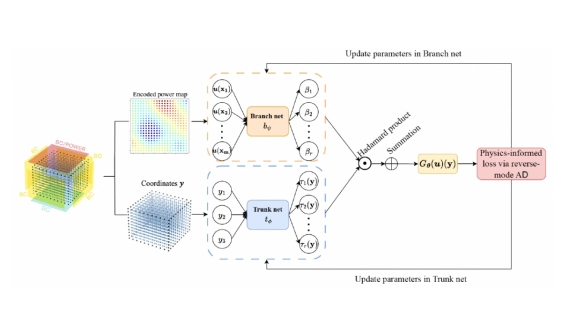DeepOHeat-v1: Efficient Operator Learning for Fast and Trustworthy Thermal Simulation and Optimization in 3D-IC Design
By Xinling Yu 1, Ziyue Liu 2, Hai Li 4, Yixing Li 3, Xin Ai 3, Zhiyu Zeng 3, Ian Young 4, Zheng Zhang 1
1 Department of Electrical and Computer Engineering, University of California, Santa Barbara, USA
2 Department of Computer Science, University of California, Santa Barbara, USA
3 Cadence Design Systems, Austin, USA
4 Intel Corporation, Hillsboro, USA

Abstract
 Thermal analysis is crucial in three-dimensional integrated circuit (3D-IC) design due to increased power density and complex heat dissipation paths. Although operator learning frameworks such as DeepOHeat [1] have demonstrated promising preliminary results in accelerating thermal simulation, they face critical limitations in prediction capability for multi-scale thermal patterns, training efficiency, and trustworthiness of results during design optimization. This paper presents DeepOHeat-v1, an enhanced physics-informed operator learning framework that addresses these challenges through three key innovations. First, we integrate Kolmogorov-Arnold Networks with learnable activation functions as trunk networks, enabling an adaptive representation of multi-scale thermal patterns. This approach achieves a 1.25× and 6.29× reduction in error in two representative test cases. Second, we introduce a separable training method that decomposes the basis function along the coordinate axes, achieving 62× training speedup and 31× GPU memory reduction in our baseline case, and enabling thermal analysis at resolutions previously infeasible due to GPU memory constraints. Third, we propose a confidence score to evaluate the trustworthiness of the predicted results, and further develop a hybrid optimization workflow that combines operator learning with finite difference (FD) using Generalized Minimal Residual (GMRES) method for incremental solution refinement, enabling efficient and trustworthy thermal optimization. Experimental results demonstrate that DeepOHeatv1 achieves accuracy comparable to optimization using highfidelity finite difference solvers, while speeding up the entire optimization process by 70.6× in our test cases, effectively minimizing the peak temperature through optimal placement of heat-generating components. Open source code is available at https://github.com/xlyu0127/DeepOHeat-v1.
Thermal analysis is crucial in three-dimensional integrated circuit (3D-IC) design due to increased power density and complex heat dissipation paths. Although operator learning frameworks such as DeepOHeat [1] have demonstrated promising preliminary results in accelerating thermal simulation, they face critical limitations in prediction capability for multi-scale thermal patterns, training efficiency, and trustworthiness of results during design optimization. This paper presents DeepOHeat-v1, an enhanced physics-informed operator learning framework that addresses these challenges through three key innovations. First, we integrate Kolmogorov-Arnold Networks with learnable activation functions as trunk networks, enabling an adaptive representation of multi-scale thermal patterns. This approach achieves a 1.25× and 6.29× reduction in error in two representative test cases. Second, we introduce a separable training method that decomposes the basis function along the coordinate axes, achieving 62× training speedup and 31× GPU memory reduction in our baseline case, and enabling thermal analysis at resolutions previously infeasible due to GPU memory constraints. Third, we propose a confidence score to evaluate the trustworthiness of the predicted results, and further develop a hybrid optimization workflow that combines operator learning with finite difference (FD) using Generalized Minimal Residual (GMRES) method for incremental solution refinement, enabling efficient and trustworthy thermal optimization. Experimental results demonstrate that DeepOHeatv1 achieves accuracy comparable to optimization using highfidelity finite difference solvers, while speeding up the entire optimization process by 70.6× in our test cases, effectively minimizing the peak temperature through optimal placement of heat-generating components. Open source code is available at https://github.com/xlyu0127/DeepOHeat-v1.
Index Terms—3D IC, thermal simulation, operator learning, kolmogorov–arnold networks.
To read the full article, click here
Related Chiplet
- Interconnect Chiplet
- 12nm EURYTION RFK1 - UCIe SP based Ka-Ku Band Chiplet Transceiver
- Bridglets
- Automotive AI Accelerator
- Direct Chiplet Interface
Related Technical Papers
- ATSim: A Fast and Accurate Simulation Framework for 2.5D/3D Chiplet Thermal Design Optimization
- 3D-ICE 4.0: Accurate and efficient thermal modeling for 2.5D/3D heterogeneous chiplet systems
- STAMP-2.5D: Structural and Thermal Aware Methodology for Placement in 2.5D Integration
- Intel and Cadence Collaboration on UCIe: Demonstration of Simulation Interoperability
Latest Technical Papers
- 3D-ICE 4.0: Accurate and efficient thermal modeling for 2.5D/3D heterogeneous chiplet systems
- Compass: Mapping Space Exploration for Multi-Chiplet Accelerators Targeting LLM Inference Serving Workloads
- Chiplet technology for large-scale trapped-ion quantum processors
- REX: A Remote Execution Model for Continuos Scalability in Multi-Chiplet-Module GPUs
- A 3D-integrated BiCMOS-silicon photonics high-speed receiver realized using micro-transfer printing